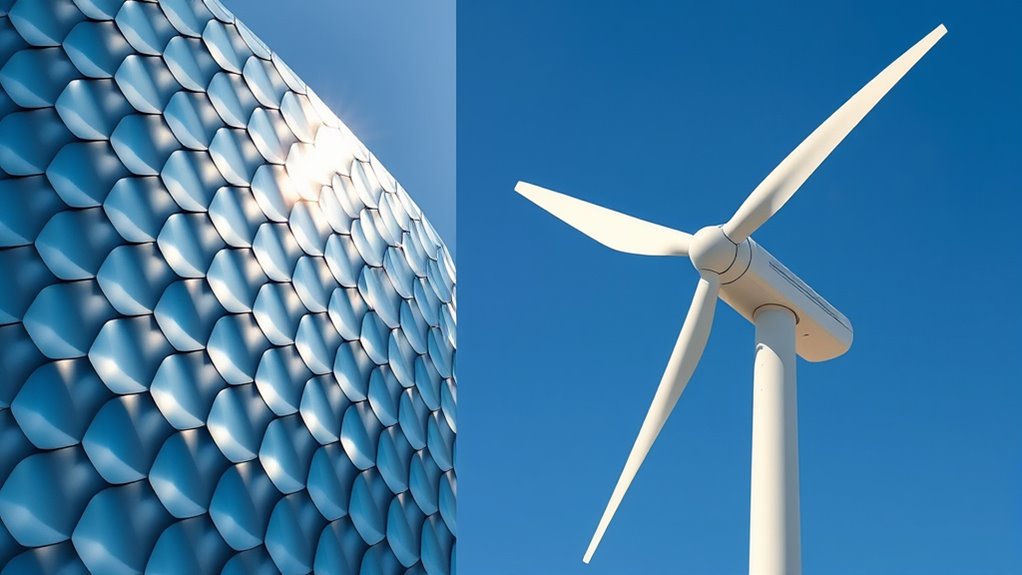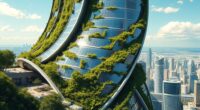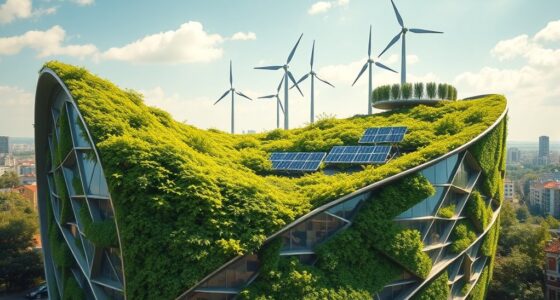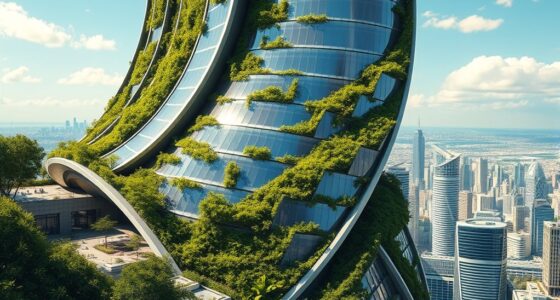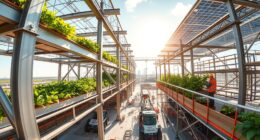Biomimicry in design draws inspiration from nature’s elegant and sustainable solutions to create innovative technologies and architecture. By mimicking natural systems—like adaptive materials that respond to environmental changes or circular water cycles—you can develop eco-friendly buildings that minimize energy use and waste. These strategies promote resilience, efficiency, and harmony with surroundings. Exploring how nature’s principles shape these innovations can reveal inspiring ideas for creating a more sustainable future.
Key Takeaways
- Biomimicry draws inspiration from nature’s efficient solutions to develop sustainable and innovative design strategies.
- Adaptive materials mimic biological responses, enabling buildings to regulate temperature and self-heal.
- Natural adaptation strategies inform resilient architecture by recycling water, waste, and energy, creating eco-friendly systems.
- System-level integration in biomimicry emphasizes interconnected cycles for self-sustaining and environmentally responsible designs.
- Incorporating ecological principles promotes future-proof innovations that harmonize with the planet’s ecosystems.

Biomimicry in design involves drawing inspiration from nature’s solutions to create innovative, sustainable products and systems. When you look to the natural world, you discover elegant strategies that have evolved over millions of years, offering practical lessons for modern design. One area where this approach truly shines is sustainable architecture. By mimicking how natural ecosystems operate, you can develop buildings that minimize environmental impact, reduce energy consumption, and promote harmony with their surroundings. For instance, structures inspired by termite mounds utilize natural ventilation to regulate internal temperatures, eliminating the need for energy-intensive air conditioning. Such biomimetic designs show that you don’t need complex technology to achieve sustainability — just a keen eye for nature’s simplicity and efficiency.
Adaptive materials play a vital role in bringing these biomimetic concepts to life. These materials can change their properties in response to environmental conditions, much like how plants and animals adapt to their surroundings. Picture windows made from adaptive materials that adjust transparency based on sunlight intensity, helping to keep indoor temperatures stable without relying heavily on heating or cooling systems. This dynamic response reduces your carbon footprint and cuts energy costs, making your buildings more sustainable. You can also incorporate materials that mimic the self-healing properties of skin or the ability of certain shells to resist wear, extending the lifespan of structures and reducing waste. This ability to adapt and heal naturally aligns with the core principles of sustainable architecture, emphasizing durability and minimal resource consumption. Additionally, understanding natural adaptation strategies can help you develop more resilient and efficient designs. Incorporating biomimetic design principles guides you toward solutions that are both innovative and ecologically responsible. As you explore these concepts, researching biomimicry in architecture can provide further inspiration and guidance.
When designing with biomimicry, it’s essential to contemplate not just the materials but also the overall system. Nature’s designs are inherently integrated, creating efficient cycles that sustain themselves. You can apply this concept by developing architectural systems that recycle water, waste, or energy, inspired by natural processes like the water cycle or the nutrient flow in ecosystems. This holistic approach ensures your designs don’t just mimic superficial features but embody the efficiencies found in nature’s blueprints. Incorporating high contrast ratios in projectors, for example, can significantly improve image quality in a variety of lighting conditions, much like how contrast enhances visual perception in natural environments. Additionally, understanding failure causes in systems can help prevent common issues and enhance resilience. By focusing on adaptive materials and sustainable architecture, you’re not only creating innovative solutions but also promoting a future where human environments work seamlessly with the planet. This approach encourages you to think beyond traditional methods, fostering creativity that aligns with ecological principles and advances sustainable living for generations to come.
Frequently Asked Questions
How Does Biomimicry Impact Sustainability in Design?
You realize that sustainability in design promotes eco-friendly materials and energy efficiency. Biomimicry enhances this by inspiring you to develop solutions that mimic nature’s efficient systems. When you incorporate natural principles, you create designs that use fewer resources, reduce waste, and lower energy consumption. This approach helps you craft innovative, sustainable products that benefit the environment while meeting human needs, making your designs more eco-conscious and responsible.
What Are the Challenges in Applying Biomimicry Principles?
Imagine trying to paint a masterpiece with a limited palette—you face challenges in capturing nature’s complexity. Applying biomimicry principles often hits ethical dilemmas, like respecting ecosystems, and technological limitations, like replicating intricate biological systems. You must navigate these hurdles carefully, balancing innovation with responsibility. Overcoming these challenges requires creativity and caution, ensuring your designs honor nature’s wisdom without causing harm or overreaching what current technology can achieve.
Can Biomimicry Be Used in Urban Planning?
You can definitely use biomimicry in urban planning by incorporating ideas like green roofs and water harvesting systems inspired by nature. These strategies mimic natural processes to improve sustainability, reduce heat, and manage stormwater efficiently. By observing how ecosystems handle resources, you can design cities that are more resilient and eco-friendly. Biomimicry offers innovative solutions that make urban environments healthier and more sustainable, aligning with nature’s own wisdom.
How Do Designers Identify Suitable Natural Models?
Ever wonder how designers find the perfect natural model? They start with natural pattern analysis, carefully studying ecosystems and organisms. Using biological analogy techniques, you can identify features that solve specific problems, like termite mounds inspiring cooling systems. This process involves observation, comparison, and creative thinking to uncover nature’s ingenious solutions. By analyzing these patterns, you can select models that inspire innovative, sustainable designs tailored to your project’s needs.
What Industries Are Most Benefiting From Biomimicry Innovations?
You’ll see that industries like fashion and aerospace benefit most from biomimicry innovations. In fashion, designers mimic natural processes for sustainable materials and textures, reducing environmental impact. In aerospace, engineers adopt natural structures to create lightweight, efficient aircraft. These industries harness biomimicry to solve complex problems, improve performance, and promote sustainability, proving how nature’s solutions can inspire groundbreaking advancements across diverse fields.
Conclusion
By embracing nature’s genius, you can turn everyday challenges into elegant solutions. Biomimicry acts as a bridge, connecting you to the wisdom of the natural world and releasing your creativity. Like a master key, it unlocks innovative ideas hidden in the tapestry of life around you. So, let nature inspire your designs, and watch your innovations flourish as effortlessly as flowers blooming in spring. Embrace biomimicry, and watch your ideas take flight.
